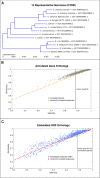Are Antisense Proteins in Prokaryotes Functional?
- PMID: 32923454
- PMCID: PMC7457138
- DOI: 10.3389/fmolb.2020.00187
Are Antisense Proteins in Prokaryotes Functional?
Abstract
Many prokaryotic RNAs are transcribed from loci outside of annotated protein coding genes. Across bacterial species hundreds of short open reading frames antisense to annotated genes show evidence of both transcription and translation, for instance in ribosome profiling data. Determining the functional fraction of these protein products awaits further research, including insights from studies of molecular interactions and detailed evolutionary analysis. There are multiple lines of evidence, however, that many of these newly discovered proteins are of use to the organism. Condition-specific phenotypes have been characterized for a few. These proteins should be added to genome annotations, and the methods for predicting them standardized. Evolutionary analysis of these typically young sequences also may provide important insights into gene evolution. This research should be prioritized for its exciting potential to uncover large numbers of novel proteins with extremely diverse potential practical uses, including applications in synthetic biology and responding to pathogens.
Keywords: antisense transcription; antisense translation; function; gene annotation; overlapping gene; selected effects.
Copyright © 2020 Ardern, Neuhaus and Scherer.
Figures



References
LinkOut - more resources
Full Text Sources

